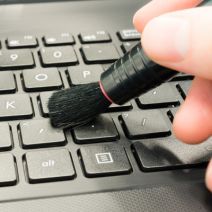 A clean computer is a happy computer. Just like any other piece of gadgetry, a computer requires regular cleanup sessions that allow users to get the most from them. In fact, January is known as Clean Up Your Computer Month, so what better way is there to ring in the new year than making sure your computer is in tip-top shape?
A clean computer is a happy computer. Just like any other piece of gadgetry, a computer requires regular cleanup sessions that allow users to get the most from them. In fact, January is known as Clean Up Your Computer Month, so what better way is there to ring in the new year than making sure your computer is in tip-top shape?
Before you start cleaning anything, though, you want to make sure that your PC is powered down and unplugged. This is important so you don’t accidentally cause harm to both yourself and your PC. Here are some suggestions for how to clean up your PC, and how to help it stay that way.
The Monitor
Let’s start with something simple; the monitor. As the thing that holds most of your attention throughout the workday, it should be pretty easy to know when it needs a good thorough cleaning. You might be surprised by how dirty a monitor can get without you noticing. Dirt, dust, fingerprints, and other gunk can accumulate to make a monitor look very unappealing, and in some cases, it can make it difficult to read properly.
Cleaning a monitor is simple enough. Just be sure that you do not spray any liquids on the screen. This makes it difficult to control the substance, and if you use too much of it and the chemicals seep into the monitor, it could cause damage. In most cases, it’s safe to just use a damp cloth to wipe off your monitor, or rubbing alcohol for LCD displays. Minimal risk is always a great way to approach PC cleaning. Once the screen is clean, it’s just a matter of wiping off or vacuuming up any remaining dust, making sure that there are no objects obstructing monitor vents.
The Keyboard
Next comes the keyboard, which you can assume is one of the nastiest, dirtiest parts of a PC setup. You can count on the keyboard being the place where most germs will reside; in fact, keyboards often have more bacteria and germs than a toilet seat! You’ll want to power-down your PC before unplugging the keyboard, especially if you’re using one of the older keyboards from the early days of computing, though it’s more likely that you’re using a USB-connected keyboard.
Start by turning the keyboard upside-down and shaking it. You’ll probably notice a ton of junk falling out of it, especially if you’re one to eat at the computer. Using compressed air is also a viable option, as it helps you get rid of food, dust particles, and dead skin (eww) that might be too stubborn to fall out on their own. If you want to get a more thorough cleaning, you can remove the keys from the keyboard. Hold down the key in front of the one you want to remove, then use a flat object like a flathead screwdriver to pop the desired key off. Once the keys you want to clean have been removed, it’s just a matter of wiping them down or blowing compressed air. As long as you haven’t spilled soda or coffee on your keyboard, this should be enough to make sure your keys stay stick-free.
The PC Itself
For cleaning up the rest of your PC, the main thing you’ll want to look at is the fan. The fans are responsible for cooling the system, but they’re notorious for collecting dust. When too much dust collects in front of the fan, it can lead to your PC overheating. You don’t need us to tell you that an overheating PC could potentially lead to long-term damage. The best way to approach cleaning out your computer fans, and any part of the computer in general, is to use compressed air. Blow the dust away from the fan in a way which allows for maximum cleaning potential.
It’s usually a good idea to give your PC a once-over with compressed air to remove any accumulating dust particles that could directly affect its ability to perform properly. Also, never, ever, spray liquids anywhere inside a computer, unless you know exactly what you’re doing. Doing so could damage internal components beyond repair.
More often than not, you’ll only be working on the computer case fan. Anything else, and you’ll have to work with the innards of your PC, which can be dangerous if you aren’t proficient in the art of caring for technology. This is why having a technology professional by your side is such a valuable investment.
It’s a good idea to clean out your computer hardware once every 6-to-12 months, depending on how dusty your work area gets.
For more great tips on how to keep your PC clean, or for help maintaining your technology, give Voyage Technology a call at 800.618.9844.


